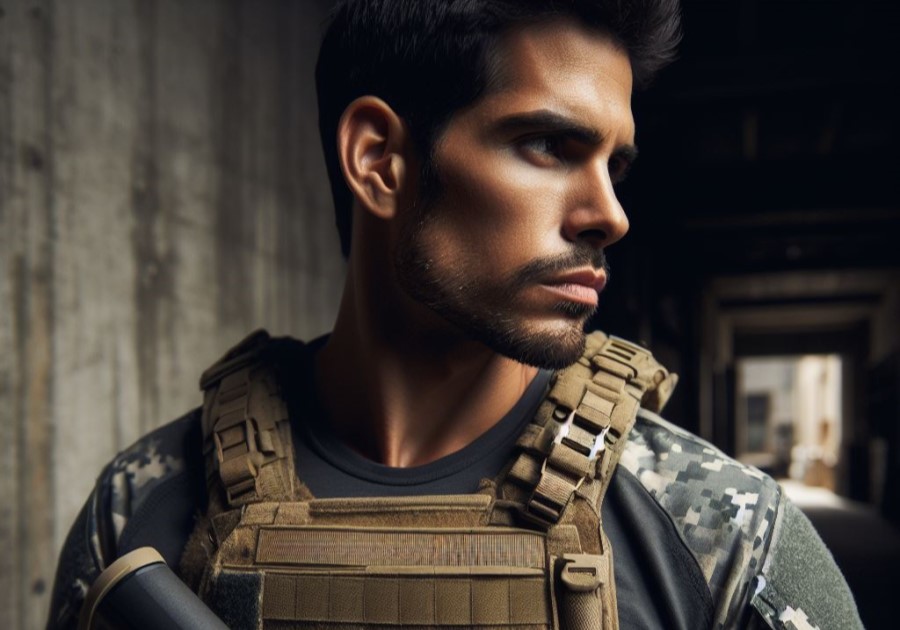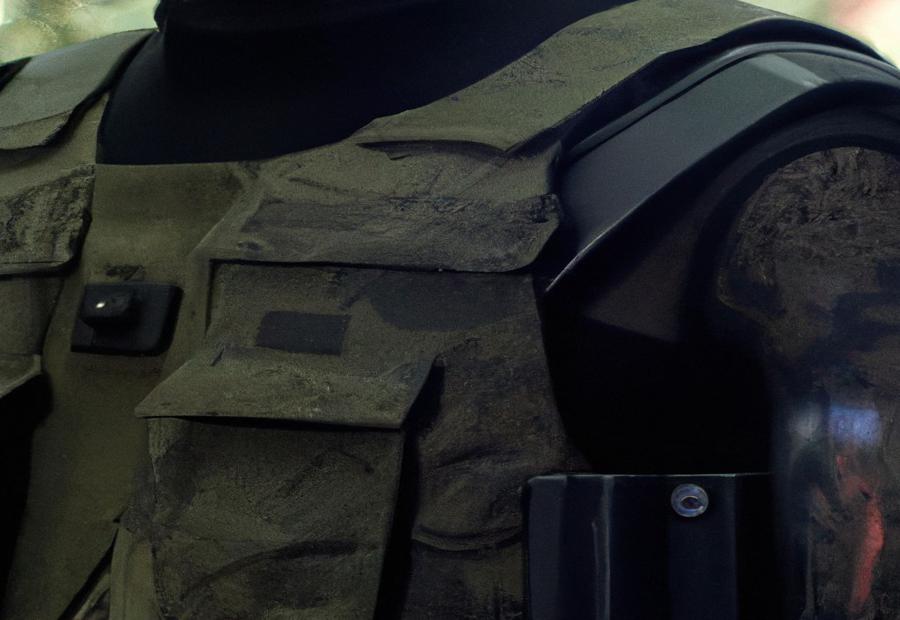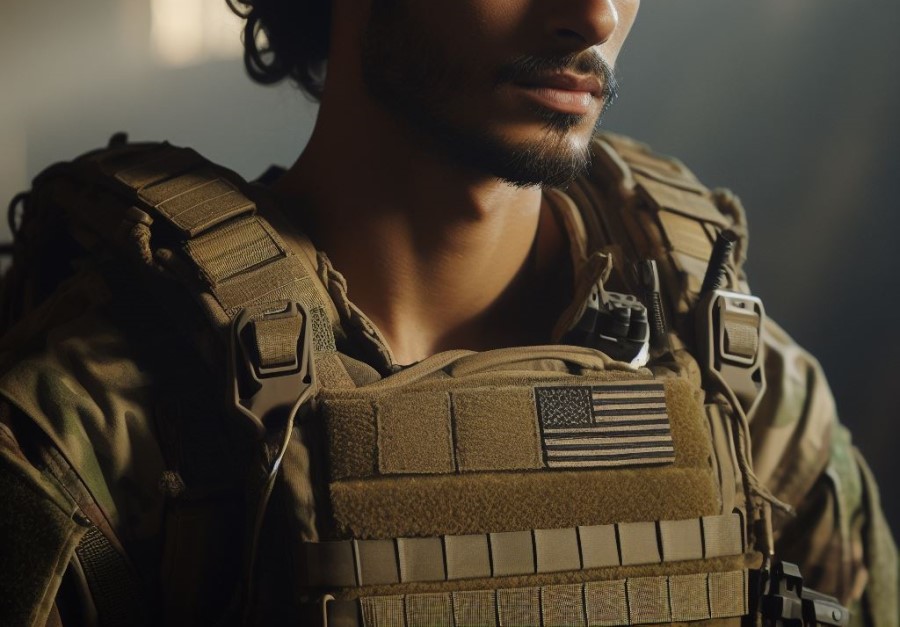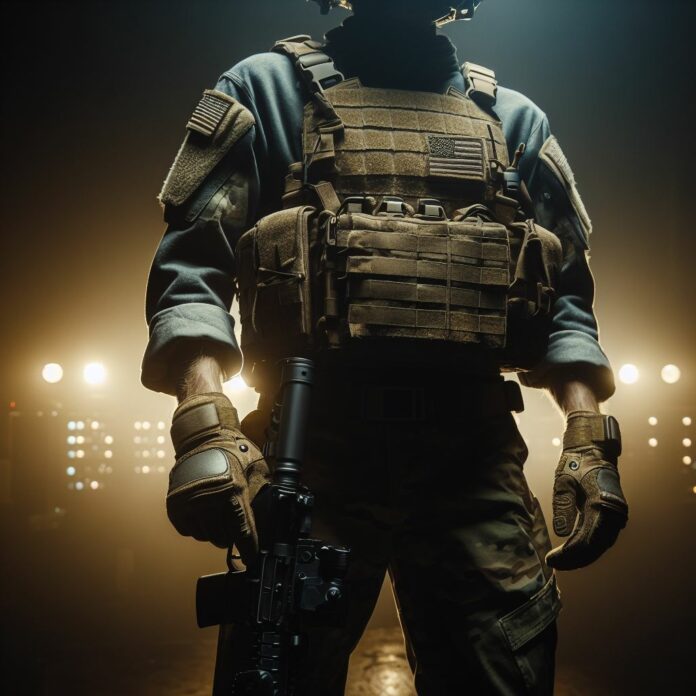Selecting the right bulletproof vest for military use is of utmost importance. The choice of a bulletproof vest can mean the difference between life and death in the battlefield.
A bulletproof vest is designed to provide protection against ballistic threats and ensure the safety of military personnel in high-risk situations. Understanding the key considerations and factors that make a bulletproof vest effective is crucial in making an informed decision.
The level of protection, fit and comfort, durability and material, weight and mobility, concealability and camouflage, and maintenance and care are all essential factors to consider when choosing a bulletproof vest.
There are various types of bulletproof vests available for military use, including soft body armor, hard plate carriers, multi-threat vests, and tactical vests. Each type has its own set of features and advantages, catering to different requirements and preferences.
To assist in the decision-making process, a step-by-step guide can be followed. This includes identifying your needs and threat level, conducting thorough research and comparison, trying on and testing vests, considering budget constraints, and seeking professional advice and recommendations.
By carefully considering these aspects and following the necessary steps, military personnel can choose a bulletproof vest that meets their specific requirements and provides optimal protection in combat situations.
Importance of Choosing the Right Bulletproof Vest

Choosing the right bulletproof vest is of utmost importance when it comes to military use. The Importance of Choosing the Right Bulletproof Vest cannot be overstated. A properly selected vest can significantly enhance the safety and protection of soldiers in combat situations.
It is crucial to select a vest that offers the required level of ballistic protection, ensuring maximum safety and minimizing the risk of injury. The right vest should be able to withstand high-velocity rounds and provide adequate coverage for vital areas of the body.
Additionally, it is important to consider factors such as comfort, weight, and mobility when choosing a bulletproof vest. The vest should allow for ease of movement and not hinder the soldier’s ability to perform their duties effectively.
Making the right choice in selecting a bulletproof vest can make a significant difference in ensuring the safety and well-being of military personnel in combat situations.
What Makes a Bulletproof Vest Effective?
A bulletproof vest is effective due to its ability to provide protection against various threats. What makes a bulletproof vest effective? Firstly, the level of protection it offers plays a crucial role. The vest should be able to withstand rifle rounds and knife attacks, providing optimum defense for military personnel.
Additionally, the fit and comfort of the vest are essential factors to consider. It should be properly fitted to ensure optimal coverage and mobility.
Durability and the material used are also important. The vest should be made from high-quality materials that can withstand wear and tear, ensuring its longevity in challenging situations. Weight and mobility are significant considerations.
The vest should be lightweight to allow for ease of movement without compromising protection.
Concealability and camouflage are necessary for military use. The vest should be designed to blend seamlessly with the surroundings, enhancing the element of surprise.
Maintenance and care are vital to ensure the vest remains effective over time. Proper cleaning and maintenance routines should be followed to extend its lifespan and functionality.
Factors to Consider When Choosing a Bulletproof Vest
Photo Credits: Paintballbuzz.Com by David Johnson
When it comes to selecting a bulletproof vest for military use, there are several crucial factors to keep in mind. In this section, we’ll explore the key considerations that should shape your decision-making process.
From the level of protection and fit to durability and weight, we’ll cover everything you need to know to make an informed choice. Plus, we’ll also delve into factors like concealability, maintenance, and more.
So, let’s dive in and discover what it takes to find the perfect bulletproof vest.
1. Level of Protection
The level of protection is a crucial factor to consider when choosing a bulletproof vest for military use. Different vests offer varying levels of protection against different types of threats.
- Level IIA: Handgun rounds up to .40 S&W
- Level II: Handgun rounds up to .357 Magnum
- Level IIIA: Handgun rounds up to .44 Magnum
- Level III: Rifle rounds such as 7.62x39mm and .308 Winchester
- Level IV: Armor-piercing rifle rounds like .30-06 AP
It is essential to assess the specific threats military personnel may encounter and choose a bulletproof vest that provides adequate protection. The vest’s level of protection should meet the requirements set by state laws or military regulations.
For example, Level IIIA protection is commonly recommended for law enforcement officers, while Level IV is necessary for intense combat situations.
2. Fit and Comfort
When considering the fit and comfort of a bulletproof vest, it is crucial to ensure that it fits the wearer properly and allows for ease of movement. The vest should snugly fit the body without restricting movement or causing any discomfort.
A proper fit guarantees that the vest remains in place during physical activity.
- To achieve a custom fit and accommodate various body shapes and sizes, adjustable straps and side panels can be utilized.
- It is essential for the vest to be lightweight to reduce fatigue and strain on the wearer. The weight distribution should be evenly spread to prevent the formation of pressure points or soreness.
- When selecting the material used in the vest, it is important to consider its impact on moisture-wicking and breathability, which enhances wearer comfort.
- To enhance comfort and prevent chafing or irritation during extended wear, padded shoulder straps and reinforced areas can be incorporated into the design of the vest.
3. Durability and Material
Durability and material are two critical factors to consider when choosing a bulletproof vest for military use. The provided table below highlights the important aspects of these factors.
Furthermore, it is crucial to note that proper maintenance and care play a significant role in sustaining the durability and effectiveness of a bulletproof vest. Following the manufacturer’s instructions and conducting regular inspections are essential to ensure the vest remains in optimal condition for maximum protection.
Fun Fact: Stephanie Kwolek developed Kevlar, one of the popular materials used in bulletproof vests, in the 1960s. Its extraordinary strength and durability have made it a vital component in safeguarding military personnel and law enforcement officers.
4. Weight and Mobility
Considering the weight and mobility of a bulletproof vest is crucial when choosing one for military use.
A lightweight vest will allow for greater maneuverability and reduce fatigue during missions.
It’s important to find a balance between protection and weight to ensure optimal performance.
Explore vests made with innovative materials and designs to enhance both mobility and protection.
Remember to consider the specific demands of your mission or role and choose a vest that meets those requirements.
By prioritizing weight and mobility, you can select a bulletproof vest that offers the necessary protection without impeding your movements.
5. Concealability and Camouflage
By taking these factors into consideration, military personnel can select a bulletproof vest that provides optimal concealability and camouflage, thereby enhancing their overall safety and effectiveness in challenging environments.
6. Maintenance and Care
When it comes to maintenance and care for your bulletproof vest, there are certain steps you should follow to ensure its effectiveness and longevity:
- Regular cleaning: Clean your bulletproof vest on a regular basis according to the manufacturer’s instructions to remove any accumulated dirt or debris over time.
- Periodic inspection for damage: Periodically inspect your vest for any signs of wear and tear, such as loose stitching or weak areas. Promptly address any damages to maintain the integrity of the vest.
- Proper storage: When not in use, store your vest in a cool, dry place away from direct sunlight. Avoid folding or compressing the vest, as this may damage its protective properties.
- Component replacement: If any components of your vest, such as straps or fasteners, become damaged or worn out, replace them to ensure proper fit and functionality.
- Adherence to maintenance guidelines: Follow the specific maintenance guidelines provided by the manufacturer to ensure your vest remains in optimal condition.
Types of Bulletproof Vests for Military Use

Photo Credits: Paintballbuzz.Com by Kevin Hall
When it comes to choosing a bulletproof vest for military use, understanding the different types is crucial. In this section, we’ll explore various options for military-grade protection. From soft body armor to hard plate carriers, multi-threat vests to tactical vests, we’ll cover them all.
Get ready to delve into the world of cutting-edge protective gear for military personnel, ensuring they have the best possible defense on the battlefield.
1. Soft Body Armor
When choosing a bulletproof vest for military use, soft body armor is an important consideration. It is designed to protect against handgun rounds and some high-velocity rifle rounds.
It is essential to choose a vest that meets the required ballistic protection level for your specific needs.
- Level of Protection: Soft body armor is designed to protect against handgun rounds and some high-velocity rifle rounds. It is essential to choose a vest that meets the required ballistic protection level for your specific needs.
- Fit and Comfort: A properly fitting vest is crucial for comfort and effective performance. Look for adjustable straps and panels that provide a secure and comfortable fit.
- Durability and Material: Soft body armor should be made from high-quality materials that are durable and resistant to wear and tear. Consider the materials used, such as ballistic fabrics, and ensure they meet the necessary standards.
- Weight and Mobility: The weight of the vest can impact mobility and flexibility. Look for lightweight options that allow for ease of movement without compromising protection.
- Concealability and Camouflage: Depending on the operational requirements, consider the vest’s ability to be concealed under clothing or its compatibility with camouflage patterns.
- Maintenance and Care: Proper maintenance and care are essential for the longevity and effectiveness of the vest. Follow the manufacturer’s guidelines for cleaning and storage.
When selecting a soft body armor vest, prioritize the level of protection, a comfortable fit, durability, mobility, concealability, and proper maintenance. It’s crucial to consult with professionals and consider the specific regulations and laws applicable to military personnel.
2. Hard Plate Carriers
Hard plate carriers, also known as bulletproof vests, are commonly used in military applications.
These vests are specifically designed to provide maximum protection against rifle rounds and other high-velocity projectiles.
Made with durable materials such as Kevlar or ceramic plates, hard plate carriers can withstand the impact of powerful projectiles.
Compared to soft body armor vests, hard plate carriers offer a higher level of protection.
They are designed to protect vital organs like the chest, back, and sides.
In combat situations with a high risk of encountering rifle fire, hard plate carriers are often used.
They provide excellent protection against threats such as rifle rounds and knife attacks.
Although hard plate carriers are typically heavier and bulkier, they offer superior protection.
Hard plate carriers often feature moisture-wicking fabrics to keep the wearer comfortable in hot and humid conditions.
When choosing a hard plate carrier, it is important to consider state laws, US laws, and different regulations that may apply.
Military personnel and individuals in high-risk professions should invest in a high-quality hard plate carrier to ensure their safety.
When selecting a hard plate carrier, important factors to consider are the level of protection, fit and comfort, durability and material, weight and mobility, camouflage, and maintenance and care.
3. Multi-Threat Vests
When selecting a bulletproof vest for military use, it is important to consider multi-threat vests that offer comprehensive protection against a variety of threats. Here are key factors to take into account:
- Level of Protection: Multi-threat vests are specifically designed to safeguard against various threats, including rifle rounds and knife attacks.
- Fit and Comfort: Ensuring that the vest fits properly and allows for comfortable movement during tactical operations is crucial.
- Durability and Material: It is essential that multi-threat vests are constructed from high-quality materials capable of withstanding the demanding conditions of military use.
- Weight and Mobility: While providing sufficient protection, the vest should not impede mobility. Lightweight options that offer enhanced maneuverability are highly preferred.
- Concealability and Camouflage: Depending on the mission, the vest should have the ability to be concealed under clothing or include camouflage options for blending with the surroundings.
- Maintenance and Care: Consider the ease of maintaining and caring for the vest to ensure its optimal condition for prolonged use.
- Soft Armor Inserts: Many multi-threat vests feature pockets for soft armor inserts, which provide an additional layer of protection.
- Moisture Wicking Fabrics: Look for vests that incorporate moisture-wicking properties to keep the wearer cool and dry during long hours of use.
- State Laws and Regulations: It is crucial to ensure that the chosen vest complies with relevant state and US laws and regulations.
By taking these factors into consideration, military personnel can select a multi-threat vest that offers effective protection and meets their specific requirements.
4. Tactical Vests
- Tactical vests are a crucial piece of equipment for military personnel.
- Designed for combat situations, tactical vests provide both protection and functionality.
- Constructed from durable materials like Kevlar or ballistic nylon, these vests ensure long-lasting performance.
- Tactical vests offer exceptional defense against rifle rounds and knife attacks.
- Many tactical vests include soft armor inserts that can be upgraded for additional security.
- With a focus on lightweight design, tactical vests prioritize optimal mobility for soldiers.
- Equipped with multiple pockets and attachment points, these vests allow for easy carriage of essential gear.
- Moisture-wicking fabrics featured in some tactical vests keep wearers cool and dry in hot conditions.
- When purchasing tactical vests, it is essential to consider state laws, US laws, and various regulations.
- Military personnel must ensure that their tactical vest meets the specific requirements of their unit and mission.
Step-by-Step Guide to Choosing a Bulletproof Vest

Looking to select the perfect bulletproof vest? This step-by-step guide has got you covered. We’ll walk you through the process of choosing a bulletproof vest, from identifying your specific needs and threat level to researching and comparing different models.
Then, we’ll discuss the importance of trying on and testing vests, considering your budget, and seeking advice from professionals. Get ready to make an informed decision and prioritize your safety with our comprehensive vest selection guide.
1. Identify Your Needs and Threat Level
When choosing a bulletproof vest for military use, it is crucial to first identify your needs and assess the threat level you might encounter. Here’s a step-by-step guide to help you:
- Research the types of threats you may face, such as rifle rounds or knife attacks.
- Consider your specific role and responsibilities within the military.
- Take into account the specific regulations and laws that apply to your jurisdiction or country, such as state laws or US laws.
- Evaluate the level of protection required based on the potential threats and regulations.
- Consider the specific characteristics needed for your body armor vest, such as weight and mobility.
- Assess the desired level of comfort and fit to ensure easy movement during operation.
- Think about the durability and materials used in the bulletproof vest to ensure long-lasting performance.
- Take into account concealability and camouflage options if necessary for your operational environment.
- Consider the maintenance and care requirements of the vest to ensure it can be properly maintained.
- Finally, factor in your budget and cost limitations when making a decision.
- It is always advisable to seek professional advice and recommendations from experts in the field.
By following these steps, you can identify your needs and assess the threat level accurately, enabling you to choose the right bulletproof vest for military use.
2. Research and Compare Vests
When it comes to choosing a bulletproof vest for military use, conducting thorough research and comparing different options is crucial. This will help ensure that you select the most suitable vest that meets your needs and requirements.
Researching and comparing vests based on these factors will allow you to make an informed decision. Consider the specific needs of military personnel, the type of body armor vest required (such as soft body armor or hard plate carriers), and the different regulations and laws that may apply.
By prioritizing these factors and diligently researching and comparing vest options, you can ensure that you select a bulletproof vest that provides optimal protection and meets the specific requirements of military use.
3. Try On and Test Vests
When selecting a bulletproof vest for military use, it is imperative to try on and test the vests to ensure optimal fit and functionality. Here are the steps to follow:
- Inspect the vest: Check for any visible damage or defects that could impact its performance.
- Try on appropriate clothing: Put on clothing similar to what you would wear under the vest in real-world scenarios.
- Adjust the straps: Ensure the vest can be securely fastened and adjusted to match your body shape.
- Move around: Walk, run, crouch, and perform other movements to ensure the vest does not restrict your mobility.
- Evaluate comfort: Wear the vest for an extended period to assess its level of comfort, including the distribution of weight.
- Simulate real-world conditions: If possible, replicate the conditions you might encounter in the field to observe how the vest performs.
It is important to note that the body shape and preferences of each individual may vary, making it necessary to find a vest that suits your specific needs. Trying on and testing vests allows you to evaluate their functionality and comfort before making a final decision.
4. Consider Budget and Cost
When considering budget and cost in choosing a bulletproof vest for military use, it is important to find a balance between affordability and quality. Here are some points to consider:
- Consider Budget and Cost: Determine the maximum amount you are willing to spend on a bulletproof vest.
- Research prices: Compare the prices of different vests from various manufacturers to get an idea of the average cost.
- Consider additional costs: Keep in mind that there may be additional expenses such as accessories, upgrades, or maintenance.
- Weigh the benefits: Consider the level of protection and features offered by each vest in relation to its cost.
- Think long-term: Investing in a high-quality vest may cost more upfront but can save you money in the long run as it will be more durable and require less frequent replacement.
- Seek recommendations: Consult with professionals or experienced military personnel for advice on cost-effective options without compromising on quality.
It is crucial to remember that the cost should not be the sole determining factor in choosing a bulletproof vest. The vest’s ability to provide adequate protection, comfort, and durability should always be top priorities.
In the mid-2000s, the US military made significant advancements in the development of lighter and more affordable bulletproof vests, greatly benefiting soldiers on the front lines.
These vests, made from advanced materials and utilizing innovative designs, provided enhanced protection while taking into consideration budget constraints. This breakthrough allowed the military to allocate more resources to other critical areas while ensuring the safety of its personnel.
Today, ongoing research and development continue to strive for even more cost-effective solutions without compromising on the quality and effectiveness of bulletproof vests.
5. Seek Professional Advice and Recommendations
When selecting a bulletproof vest for military use, it is crucial to seek professional advice and recommendations. This step ensures that you make an informed decision. Follow these steps:
- Conduct research to find reputable experts and professionals specializing in body armor.
- Contact these experts and arrange consultation sessions to discuss your specific needs and requirements.
- During the consultation, provide detailed information about your operational environment, potential threats, and mission requirements.
- Pay close attention to the advice and recommendations provided by the professionals. Take into account their expertise and experience when making your decision.
- Ask questions and seek clarification on any areas that you are uncertain about.
- Take notes during the consultation to refer back to when comparing different options.
- Consider seeking recommendations from military colleagues or superiors who have experience in using bulletproof vests.
- Gather the advice and recommendations you receive and compare them against each other.
- Evaluate the advantages and disadvantages of each recommendation in relation to your specific circumstances.
- Make an informed decision based on the professional advice and recommendations you have received.
By seeking professional advice and recommendations, you can benefit from the expertise of those knowledgeable about bulletproof vests and their effectiveness.
This will help you choose a vest that best suits your needs and provides the necessary level of protection for your military operations.
Frequently Asked Questions
How to choose a bulletproof vest for military use?
Choosing a bulletproof vest for military use requires careful consideration of several factors, including the specific threats faced by military personnel. Here are some frequently asked questions and answers to help guide your selection:
What are the different types of body armor suitable for military use?
There are several types of body armor suitable for military use, including covert soft armor, overt soft armor, and hard plate armor. Covert soft armor is worn under clothes for discreet protection, overt soft armor is worn over clothes for visible protection, and hard plate armor provides extra protection against high-impact threats.
What materials are commonly used in military-grade bulletproof vests?
Military-grade bulletproof vests are typically made from advanced ballistic-resistant materials such as DuPont Kevlar and Ultra-High-Molecular-Weight PolyEthylene (UHMWPE). These materials provide high strength and energy absorption, offering effective protection against firearm-fired projectiles.
What are the recommended protection levels for military-grade bulletproof vests?
The recommended protection levels for military-grade bulletproof vests depend on the specific threats faced in war zones. The United States National Institute of Justice (NIJ) provides five threat levels, ranging from Level IIA to Level IV.
Military personnel may require vests with higher protection levels, such as Level III or IV, to defend against powerful ammunition and explosive fragments.
Are there any specialized ballistic vests designed for military use?
Yes, there are specialized ballistic vests available for military use. These vests often feature additional components like MOLLE loops for attaching gear, camouflage patterns for improved concealment, and hard armor plates for enhanced protection against high-velocity projectiles.
Are there different laws or regulations regarding the possession and use of bulletproof vests in different countries?
Yes, different countries have varying laws and regulations regarding the possession and use of bulletproof vests. It is important to research and comply with the specific laws and regulations of your country or the country where the military operation is taking place.
Some countries may restrict or regulate the use of body armor by civilians or non-military personnel.
What are the key considerations for military personnel when selecting a bulletproof vest?
Military personnel must consider several factors when selecting a bulletproof vest, such as the level of protection required, the vest’s weight and mobility, compatibility with other gear, and the specific threats faced in their operational environment.
It is crucial to choose a vest that provides optimal protection without compromising comfort and maneuverability, as the right vest can be life-saving on the battlefield.

